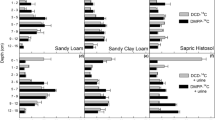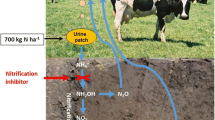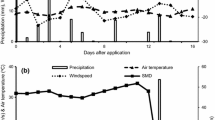Abstract
Purpose
Dairy winter forage grazing on free-draining soils is a common practice within the Canterbury region of New Zealand. The high stocking rates involved and the associated deposition of urine onto wet soils during winter create a high risk of nitrate (NO3 −) leaching from soil. The objective of this study was to determine the effect of animal trampling and the use of a nitrification inhibitor, dicyandiamide (DCD), on soil ammonia oxidisers, nitrification, and nitrate leaching under simulated winter forage grazing conditions.
Materials and methods
A lysimeter trial was carried out using a Balmoral stony silt loam under a kale forage crop. Nitrate leaching losses, the effect of soil trampling, and the effect of DCD were measured. Soil nitrification rates and ammonia-oxidising community abundance and activity were measured in companion soil blocks under simulated dairy winter forage grazing conditions.
Results and discussion
Animal trampling was found to reduce peak nitrate-N (NO3 --N) concentrations in drainage water from urine patch areas by 43 %. In addition, animal trampling reduced the total amount of NO3 −-N leached from urine patches by 34 %. However, animal trampling did not affect the growth or activity of the ammonia oxidisers. The use of DCD was found to be highly effective in reducing the concentration and amount of NO3 −-N leached from urine patches. Dicyandiamide applications reduced peak NO3 −-N concentrations in drainage water by 66 %, and the total amount of NO3 −-N leached was reduced by 61 % under the simulated dairy winter forage grazing conditions. Ammonia oxidising bacteria (AOB) were more abundant than ammonia-oxidising archaea (AOA) and were responsible for mediating the nitrification process.
Conclusions
These results suggest that both animal trampling and the use of DCD separately reduces soil nitrification rates and thus NO3 − leaching.








Similar content being viewed by others
References
Ball BC, Cameron KC, Di HJ, Moore S (2012) Effects of trampling of a wet dairy pasture soil on soil porosity and on mitigation of nitrous oxide emissions by a nitrification inhibitor, dicyandiamide. Soil Use Manag 28(2):194–201
Baolan H, Shuai L, Wei W, Lidong S, Liping L, Weiping L, Guangming T, Xiangyang X, Ping Z (2014) pH-dominated niche segregation of ammonia-oxidising microorganisms in Chinese agricultural soils. FEMS Microbiol Ecol. doi:10.1111/1574-6941.12391
Blakemore LC, Searle PL, Daly BK (1987) Methods for chemical analysis of soils. NZ Soil Bur Sci Rep 80
Cameron KC, Smith NP, McLay CDA, Fraser PM, McPherson RJ, Harrison DF, Harbottle P (1992) Lysimeters without edge flow—an improved design and sampling procedure. Soil Sci Soc Am J 56(5):1625–1628
Cameron KC, Di HJ, Moir JL (2013) Nitrogen losses from the soil/plant system: a review. Ann Appl Biol 162(2):145–173
de Klein CAM, Eckard RJ (2008) Targeted technologies for nitrous oxide abatement from animal agriculture. Aust J Exp Agric 48(1–2):14–20
Di HJ, Cameron KC (2002) The use of a nitrification inhibitor, dicyandiamide (DCD), to decrease nitrate leaching and nitrous oxide emissions in a simulated grazed and irrigated grassland. Soil Use Manag 18(4):395–403
Di HJ, Cameron KC (2004) Treating grazed pasture soil with a nitrification inhibitor, eco-n (TM), to decrease nitrate leaching in a deep sandy soil under spray irrigation—a lysimeter study. N Z J Agric Res 47(3):351–361
Di HJ, Cameron KC, Shen JP, He ZJ, Winefield CS (2009a) A lysimeter study of nitrate leaching from grazed grassland as affected by a nitrification inhibitor, dicyandiamide, and relationships with ammonia oxidizing bacteria and archaea. Soil Use Manag 25(4):454–461
Di HJ, Cameron KC, Shen JP, Winefield CS, O’Callaghan M, Bowatte S, He JZ (2009b) Nitrification driven by bacteria and not archaea in nitrogen-rich grassland soils. Nat Geosci 2(9):621–624
Di HJ, Cameron KC, Shen JP, Winefield CS, O’Callaghan M, Bowatte S, He JZ (2010) Ammonia-oxidizing bacteria and archaea grow under contrasting soil nitrogen conditions. FEMS Microbiol Ecol 72(3):386–394
Drewry JJ, Paton RJ (2005) Soil physical quality under cattle grazing of a winter-fed brassica crop. Aust J Soil Res 43(4):525–531
Francis CA, Roberts KJ, Beman JM, Santoro AE, Oakley BB (2005) Ubiquity and diversity of ammonia-oxidizing archaea in water columns and sediments of the ocean. Paper presented at the Proceedings of the National Academy of Sciences of the United States of America
Griffiths RI, Whiteley AS, O’Donnell AG, Bailey MJ (2000) Rapid method for coextraction of DNA and RNA from natural environments for analysis of ribosomal DNA- and rRNA-based microbial community composition. Appl Environ Microbiol 66(12):5488–5491
He J, Shen J, Zhang L, Zhu Y, Zheng Y, Xu M, Di H (2007) Quantitative analyses of the abundance and composition of ammonia-oxidizing bacteria and ammonia-oxidizing archaea of a Chinese upland red soil under long-term fertilization practices. Environ Microbiol 9(12):3152–3152
Hewitt AE (1998) New Zealand Soil Classification, 2nd edn. Manaaki Whenua, Lincoln
Jetten MSM (2008) The microbial nitrogen cycle. Environ Microbiol 10(11):2903–2909
Kowalchuk GA, Stephen JR (2001) Ammonia-oxidizing bacteria: a model for molecular microbial ecology. Annu Rev Microbiol 55(1):485–529
Leininger S, Urich T, Schloter M, Schwark L, Qi J, Nicol GW, Prosser JI, Schuster SC, Schleper C (2006) Archaea predominate among ammonia-oxidizing prokaryotes in soils. Nature 442:806–809
Moir JL, Wild MA, Cameron KC, Di HJ (2010) The effect of DCD on nitrogen losses from sheep urine patches applied to lysimeters in autumn. Paper presented at the Proceedings of the New Zealand Grassland Association, Lincoln
Offre P, Prosser JI, Nicol GW (2009) Growth of ammonia-oxidizing archaea in soil microcosms is inhibited by acetylene. FEMS Microbiol Ecol 70(1):99–108
Parfitt RL, Couper J, Parkinson R, Schon NL, Stevenson BA (2012) Effect of nitrogen fertilizer on nitrogen pools and soil communities under grazed pastures. N Z J Agric Res 55(3):217–233
Rotthauwe JH, Witzel KP, Liesack W (1997) The ammonia monooxygenase structural gene amoA as a functional marker: molecular fine-scale analysis of natural ammonia-oxidizing populations. Appl Environ Microbiol 63(12):4704–4712
Shen J, Zhang L, Zhu Y, Zhang J, He J (2008) Abundance and composition of ammonia-oxidizing bacteria and ammonia-oxidizing archaea communities of an alkaline sandy loam. Environ Microbiol 10(6):1601–1611
Shepherd M, Wyatt J, Welten B, Ledgard S (2010) Form of nitrogen leaching from dairy cow urine and effectiveness of dicyandiamide: not all soils are equal. Paper presented at the Proceedings of the 19th World Congress of Soil Science, Brisbane
Soil Survey Staff (1998) Keys to soil taxonomy, 8th edn. United States Department of Agriculture, Washington
Valentine DL (2007) Adaptations to energy stress dictate the ecology and evolution of the Archaea. Nat Rev Microbiol 5:316–323
Williamson JC, Menneer JC, Torrens RS (1996) Impact of dicyandiamide on the internal nitrogen cycle of a volcanic, silt loam soil receiving effluent. Appl Soil Ecol 4(1):39–48
Xia W, Zhang C, Zeng X, Feng Y, Weng J, Lin X, Zhu J, Xiong Z, Xu J, Cai Z, Jia Z (2011) Autotrophic growth of nitrifying community in an agricultural soil. ISME J 5(7):1226–1236
Zhang L, Offre PR, He J, Verhamme DT, Nicol GW, Prosser JI (2010) Autotrophic ammonia oxidation by soil thaumarchaea. Paper presented at the Proceedings of the National Academy of Sciences of the United States of America
Acknowledgments
The authors were grateful to the New Zealand Ministry for Business, Innovation and Employment (MBIE) for funding this work, and Trevor Hendry, Steve Moore, Jie Lei, and Neil Smith for the technical support.
Author information
Authors and Affiliations
Corresponding author
Additional information
Responsible editor: Ian Anderson
Rights and permissions
About this article
Cite this article
Hill, AM., Di, H.J., Cameron, K. et al. The effect of animal trampling and DCD on ammonia oxidisers, nitrification, and nitrate leaching under simulated winter forage grazing conditions. J Soils Sediments 15, 972–981 (2015). https://doi.org/10.1007/s11368-014-1001-6
Received:
Accepted:
Published:
Issue Date:
DOI: https://doi.org/10.1007/s11368-014-1001-6




